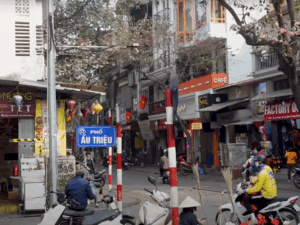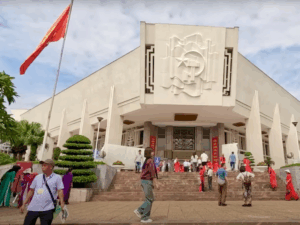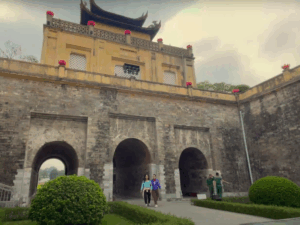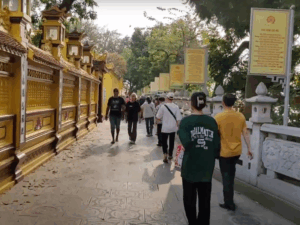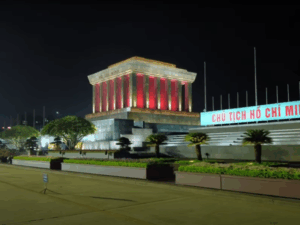Vietnam is known for its rich heritage and cultural legacy, evident in its majestic temples and intricate pagodas that have withstood the test of time. One of the most iconic sights in the country is the Pagoda, a unique architectural marvel that attracts visitors from all over the world. Located in the heart of Hanoi, the Pagoda is a symbolic representation of the Buddhist culture that has shaped the country’s history. Built in 1049, the pagoda has undergone numerous restoration works over the years but still retains its original charm and beauty. If you are a history enthusiast or simply looking for a cultural experience, here’s a comprehensive guide to help you discover the wonders of Pagoda.
One Pillar Pagoda: A Timeless Marvel of Vietnamese Architecture
Nestled in the historic heart of Hanoi, the One Pillar Pagoda stands as a profound testament to the spiritual and architectural heritage of Vietnam. Admired by history enthusiasts, travel aficionados, and architecture buffs, this pagoda reflects an era of serenity and devotion in the country’s rich past. Crafted with a meticulousness that has withstood the test of time, the One Pillar Pagoda remains an iconic structure that beckons visitors to step into a world where faith meets grandeur.
In 1049, Emperor Ly Thai Tong of the Ly Dynasty, inspired by a dream about the Goddess of Mercy handing him a baby son while seated on a lotus flower, commissioned the construction of the pagoda. Symbolically, the pagoda was designed to resemble a lotus blossom emerging from the water, a metaphor for purity and enlightenment in Buddhist symbolism. The structure’s unique architectural style, resting on a single stone pillar in the midst of a small pond, represents the harmonious blend of Vietnamese culture with Buddhist philosophy. Over the centuries, the One Pillar Pagoda has undergone several reconstructions, most notably after being partially destroyed during the French colonial period. Yet, each restoration has faithfully preserved its original allure, making it not just a relic of the past, but a living piece of Vietnam’s enduring cultural legacy.
Introduction to the One Pillar Pagoda
A Brief History of Significance
Originally christened Dien Huu tu, which translates to “Lien Hoa Dai” or the “The Lotus Lagoon,” the One Pillar Pagoda was commissioned by Emperor Ly Thai Tong. The Emperor, who ruled from 1028 to 1054, is said to have dreamed of the bodhisattva Avalokiteshvara, who presented him a baby son while seated on a lotus flower. This inspired the creation of a pagoda designed to resemble a lotus blooming on its stalk, thus the quintessential ‘one pillar’ design was born.
This architectural masterpiece is not only significant for its design but also for its symbolic representation of Vietnamese culture and Buddhist philosophy. The lotus, which is known to grow in muddy water but bloom pristinely above the surface, signifies purity, enlightenment, and rebirth. This symbolism deeply resonates with the Vietnamese people, who see the One Pillar Pagoda as a beacon of hope and spiritual growth. The pagoda’s design, featuring a single, slender pillar supporting a wooden lotus-shaped structure, showcases the unique blend of indigenous architectural styles and Buddhist influences that characterize Vietnam’s historical monuments. Today, the One Pillar Pagoda stands as a testament to Vietnam’s resilience, cultural richness, and spiritual depth, continuing to attract pilgrims and tourists alike, drawn by its fascinating history and serene beauty.
The significance lies not only in the spiritual message portrayed in its architecture but also in its offering to the goddess of mercy, Quan Am. It is believed that the pagoda was constructed by the Emperor as a symbol of his gratitude for the deity’s compassionate guidance. The One Pillar Pagoda stands as an embodiment of divine grace and the continuity of the Vietnamese people’s spiritual roots.
Historical Context
The 11th Century Era of Construction
The 11th century was a pivotal time for Vietnamese history. Emperor Ly Thai Tong, known for his devotion to Buddhism, sought to establish a site of reverence that would leave an indelible mark on the social fabric of Vietnam. This was also a period of political turmoil, marked by wars and power struggles. The One Pillar Pagoda, thus, emerged from the confluence of faith and a quest for stability.
Vietnamese Buddhism, at the time, was undergoing significant influence from Chinese Mahayana Buddhism. The One Pillar Pagoda’s inaugural years witnessed an adherence to Buddhist teachings and practices, and the pagoda’s design was a reflection of this amalgamation, incorporating both Vietnamese and Chinese architectural elements, but with a distinct Vietnamese flair.
Cultural and Architectural Uniqueness
The architectural design of the One Pillar Pagoda is unlike any other in the world, characterized by its unique single-pillar support structure, which is designed to resemble a lotus flower rising out of the water. This symbolism is deeply rooted in Buddhist teachings, where the lotus flower represents purity and enlightenment, emerging unsoiled from the muddy waters below. The pagoda’s design is a metaphor for how purity and beauty can arise from difficult circumstances, reflecting the resilience and perseverance of the Vietnamese people. Over the centuries, despite natural disasters and wars that led to its damage and reconstruction, the essence of the pagoda’s original design has been preserved, making it a timeless emblem of Vietnam’s cultural and spiritual heritage.
Architectural Features
The One Pillar Design Exposed
The name ‘One Pillar’ is derived from the pagoda’s unique structural feature — a single pillar supporting the entire edifice. Each element of the pagoda’s design is laden with symbolic meaning, with the lotus flower standing as a representation of purity and the enlightenment that emanates from a noble, clean soul. The pagoda is intricately crafted with red-lacquered wood, designed to withstand the ravages of time and symbolize longevity.
Preservation Efforts and Modern Challenges
In recent years, the One Pillar Pagoda has faced various modern challenges, including urban development pressures and environmental factors that threaten its structural integrity and aesthetic beauty. Preservation efforts have thus become crucial to ensuring that this iconic structure, along with its deep cultural and spiritual significances, is safeguarded for future generations. These initiatives involve not only physical restoration work but also the promotion of the pagoda as a vital part of Vietnam’s heritage, aiming to educate both locals and tourists about its importance and the need for its conservation.
The pagoda’s small, square structure supports a pyramidal roof, reminiscent of a traditional communal hall. The roof is crowned with intricate carvings that serve as testament to the remarkable skill of the ancient Vietnamese artisans. The One Pillar Pagoda’s design harmoniously integrates with the natural surroundings, as if the pagoda grew organically from the ground it stands upon.
Impact and Legacy
Cultural and Historical Reflections
For centuries, the One Pillar Pagoda has been a beacon of spiritual guidance and a structural illustration of steadfast devotion. The pagoda has also been profoundly influential in shaping Vietnamese identity, not only through its religious significance but also as an architectural treasure that exemplifies the nation’s unique aesthetic sensibilities.
Its emblematic presence in Hanoi defines the city’s landscape, making it a focal point for cultural celebrations, religious ceremonies, and a source of inspiration for artists and poets throughout the ages. In addition to its spiritual and cultural importance, the One Pillar Pagoda stands as a symbol of perseverance and resilience, having withstood the tests of time including periods of colonialism and conflict. The enduring allure of the pagoda reflects the unwavering spirit of the Vietnamese people, and its legacy continues to influence contemporary society, bridging the past with the present and future.
The pagoda has borne witness to a multitude of historical events and remains a testament to Vietnam’s resilience. Its image has been immortalized in art and literature, continuing to inspire national pride. The One Pillar Pagoda’s legacy endures in the hearts of Vietnamese people, symbolizing their tenacity, spiritual roots, and cultural richness.
Visiting the One Pillar Pagoda
Travelers’ Practical Guide
Travelers seeking to witness the allure of the One Pillar Pagoda should plan to visit during daylight hours. Hanoi’s climate, particularly during springtime, provides a picturesque vista with clear skies, enhancing the serenity and beauty of the site. Short and sweet, a visit to the pagoda could be effortlessly combined with a tour of the Temple of Literature and the Ho Chi Minh Mausoleum, all of which are within close proximity.
To make the most of your visit, it is advisable to wear comfortable walking shoes, as exploring the area involves a fair amount of walking. Additionally, as the One Pillar Pagoda is a place of worship, visitors should dress modestly out of respect for the local customs and traditions. Photography is allowed, but it is recommended to do so discreetly and with mindfulness towards others who are there for religious and spiritual reasons. Lastly, while entrance to the pagoda is free, small donations are appreciated as they go towards the maintenance and preservation of this historic site.
For those eager to absorb the historical and spiritual significance of the pagoda, local guides are available to accompany and enlighten visitors. Take the time to walk around the Lotus Pond and observe the fish that populate its waters, as these serve as additional symbols of the virtues the pagoda embodies.
Conclusion
The One Pillar Pagoda stands not just as a historical relic, but as a living monument to the enduring soul of Vietnamese culture. Its significance in architectural history, spiritual symbolism, and cultural memory remains as poignant today as it was in the 11th century. By acknowledging the past, we gain new perspectives on not just the structures we inherit but also the values they represent.
The One Pillar Pagoda invites us to ponder our own pillars — the values and beliefs that sustain us. It’s a reminder of the resilience of the human spirit, a beacon of beauty etched through strife, and a promise of continuity that time cannot erode. It serves as a call to preserve our heritage and a promise of hope for generations to come.
Visiting the One Pillar Pagoda offers more than just an opportunity to witness a marvel of ancient architecture; it provides a moment to connect with the enduring legacy of Vietnamese culture. Each step taken around its grounds whispers stories of the past, inviting reflections on the lessons and inspirations that such a historic site can offer to our modern lives. In a world that moves rapidly towards the future, the One Pillar Pagoda stands as a serene reminder of the importance of grounding ourselves in the wisdom of our ancestors, appreciating the beauty in simplicity, and nurturing the spirit of resilience and renewal.
References and Further Reading
For an in-depth understanding and exploration of the One Pillar Pagoda, we recommend the following sources:
“Lien Hoa Dai – Lotus on the Water.” Vietnamese Studies Association.
“The One Pillar Pagoda – A Lotus In The Mist.” Hanoi Museum.
“Sacred Places in Hanoi.” Vietnam National Administration of Tourism.
These resources provide scholarly insights, historical context, and vibrant descriptions that will further enrich your appreciation of this architectural jewel. Whether you plan to visit in person or wish to immerse yourself in the cultural and historical depths from afar, the One Pillar Pagoda is an educational and evocative point of departure for your exploration of Vietnamese heritage.
Beyond its historical and architectural significance, the One Pillar Pagoda symbolizes the resilience and rebirth characteristic of Vietnam’s spirit through the ages. Constructed by Emperor Lý Thái Tông in the 11th century and rebuilt multiple times after periods of decline and destruction, it serves as a testament to the persistent determination of the Vietnamese people to preserve their cultural identity amidst adversity. This enduring landmark not only captivates visitors with its unique beauty but also inspires a deep respect for the cultural tenacity and innovation that define Vietnam. Its continued existence and the reverence it commands are powerful reminders of the strength found in unity and the importance of safeguarding our cultural legacies for future generations to cherish and learn from.
One Pillar Pagoda is a fascinating destination that should be on the bucket list of any history or culture enthusiast. The sight is an excellent representation of Vietnam’s rich Buddhist heritage and cultural significance that has been preserved over the years. A visit to One Pillar Pagoda in Hanoi is an opportunity to learn more about Vietnamese history and appreciate the beauty of the country’s traditional landmarks.
- Uncover Cambodia’s Hidden Charms 6 Days / 5 Nights (121 views)
- The Best Exotic Vietnam – 16 Days / 15 Nights (111 views)
- Seamless Cruise: Halong Bay to Da Nang – Fostering smooth travel experience from Halong Bay to Da Nang. (51 views)
- Vietnam Culinary Tour: Your Definitive Guide to a Food Lover’s Journey (48 views)
- Top Vietnam Tour Operators – The Ultimate Guide to the Best Tour Companies for Vietnam (48 views)



